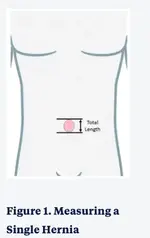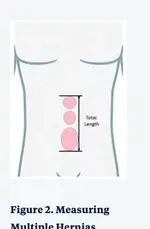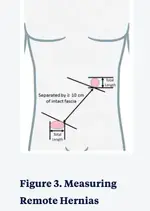Placing codes out of numerical order
allows for clustering of similar procedures, and can help the medical coder find exactly the right procedure code. These out-of-sequence codes typically have a note instructing the coder to flip to the correct code elsewhere in the book.
2023 CPT page 389 07 Digestive
Codes 49591–49596 and 49613–49618 describe repair of an anterior abdominal hernia(s) (epigastric, incisional, ventral, umbilical, spigelian) by any approach (open, laparoscopic, robotic). Codes 49591–49596 and 49613–49618 are reported only once, based on the total defect size for one or more anterior abdominal hernia(s). When both reducible and incarcerated/strangulated anterior abdominal hernias are repaired at the same operative session, all hernias are reported as incarcerated/strangulated.
Codes 49591–49596 and 49613–49618 are reported only once, based on the total defect size for one or more anterior abdominal hernia(s). In addition, the total hernia defect size should be measured before opening the hernia defect(s) because during repair the fascia typically will retract, creating a falsely elevated measurement. Hernia measurements are performed either in the transverse or craniocaudal dimension. The total length of the defect(s) corresponds to the maximum width or height of an oval drawn to encircle the outer perimeter of all repaired defects. If the defects are not contiguous and are separated by greater than or equal to 10 cm of intact fascia, total defect size is the sum of each defect measured individually. Without a total size indicated, coders may be inclined to report the hernia repair code for the smallest defect. Therefore, it will be very important to document the total defect size in the operative report so coders will know which code to select.
►Codes 49591-49618 describe repair of an anterior
abdominal hernia(s) (ie, epigastric, incisional, ventral,
umbilical, spigelian) by any approach (ie, open,
laparoscopic, robotic). Codes 49591-49618 are reported
only once, based on the total defect size for one or more
anterior abdominal hernia(s), measured as the maximal
craniocaudal or transverse distance between the outer
margins of all defects repaired. For example, "Swiss
cheese" defects (ie, multiple separate defects) would be
measured from the superior most aspect of the upper
defect to the inferior most aspect of the lowest defect. In
addition, the hernia defect size should be measured prior
to opening the hernia defect(s) (ie, during repair the
fascia will typically retract creating a falsely elevated
measurement).
When both reducible and incarcerated or strangulated
anterior abdominal hernias are repaired at the same
operative session, all hernias are reported as incarcerated
or strangulated. For example, one 2-cm reducible initial
incisional hernia and one 4-cm incarcerated initial
incisional hernia separated by 2 cm would be reported as
an initial incarcerated hernia repair with a maximum
• 49592 less than 3 cm, incarcerated or strangulated
• 49593 3 cm to 10 cm, reducible
• 49594 3 cm to 10 cm, incarcerated or strangulated
• 49595 greater than 10 cm, reducible
• 49596 greater than 10 cm, incarcerated or strangulated
#• 49613 Repair of anterior abdominal hernia(s) (ie, epigastric,
incisional, ventral, umbilical, spigelian), any approach (ie,
open, laparoscopic, robotic), recurrent, including
implantation of mesh or other prosthesis when performed,
total length of defect(s): less than 3 cm, reducible
49614 less than 3 cm, incarcerated or strangulated
49615 3 cm to 10 cm, reducible
49616 3 cm to 10 cm, incarcerated or strangulated
49617 greater than 10 cm, reducible
49618 greater than 10 cm, incarcerated or strangulated

Figure 1 depicts measuring a single anterior abdominal hernia defect, such as an umbilical hernia.

Figure 2 depicts measuring multiple anterior abdominal hernia defects. For example, Swiss cheese defects would be measured from the superior-most aspect of the upper defect to the inferior-most aspect of the lowest defect.

Figure 3 depicts measuring remote abdominal hernia defects separated by 10 cm or more of intact fascia, such as a defect in the lower right quadrant from a prior open appendectomy and a separate hernia in the upper left quadrant from a previous laparoscopic port placement.
Learn about key updates regarding 2023 CPT coding changes, including modifications to coding for anterior abdominal hernia repair.

www.facs.org


 Figure 1 depicts measuring a single anterior abdominal hernia defect, such as an umbilical hernia.
Figure 1 depicts measuring a single anterior abdominal hernia defect, such as an umbilical hernia. Figure 2 depicts measuring multiple anterior abdominal hernia defects. For example, Swiss cheese defects would be measured from the superior-most aspect of the upper defect to the inferior-most aspect of the lowest defect.
Figure 2 depicts measuring multiple anterior abdominal hernia defects. For example, Swiss cheese defects would be measured from the superior-most aspect of the upper defect to the inferior-most aspect of the lowest defect. Figure 3 depicts measuring remote abdominal hernia defects separated by 10 cm or more of intact fascia, such as a defect in the lower right quadrant from a prior open appendectomy and a separate hernia in the upper left quadrant from a previous laparoscopic port placement.
Figure 3 depicts measuring remote abdominal hernia defects separated by 10 cm or more of intact fascia, such as a defect in the lower right quadrant from a prior open appendectomy and a separate hernia in the upper left quadrant from a previous laparoscopic port placement.
 www.facs.org
www.facs.org
 helpdesk.cco.us
helpdesk.cco.us
